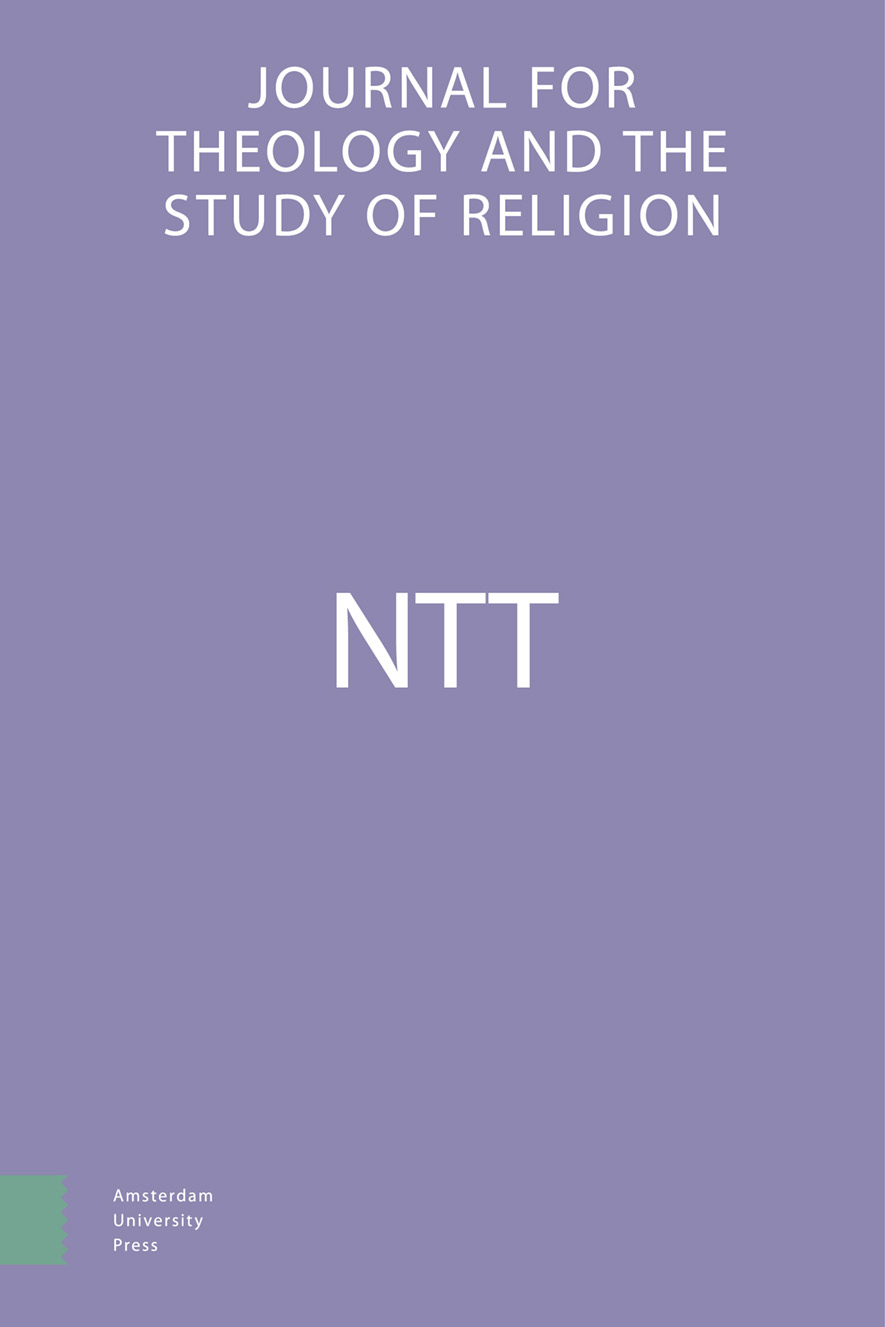- Home
- A-Z Publications
- NTT Journal for Theology and the Study of Religion
- Previous Issues
- Volume 71, Issue 2, 2017
NTT Journal for Theology and the Study of Religion - Volume 71, Issue 2, 2017
Volume 71, Issue 2, 2017
Language:
English
-
-
De parabels van Jezus en van de Rabbijnen als ‘media’ van Tora
More LessAbstract This study provides the outline of the Research Project ‘Parables and the Partings of the Ways’, a comparative reading of Rabbinic and synoptic parables (Utrecht and Tilburg Universities, 2014–2019). It delineates the status quaestionis of comparative parable research, focusses on issues of form and rhetoric of parables and argues a multi-faceted methodology to study parables as religious media or ‘sensational for Read More
-
-
-
[Summary, Alleen bruiden, slavinnen en weduwen? De rol van vrouwen in vroegrabbijnse en vroegchristelijke gelijkenissen]
More LessAuthors: Albertina Oegema, Jonathan Pater & Martijn StoutjesdijkSummary Some scholars have argued that the parables attributed to Jesus in the New Testament featuring women as characters have had a specifically radical and liberating quality for women within early Christianity. The present article challenges a similar appreciation of the texts by comparing them to rabbinic parables which use the same imagery and narrative techniques. This comparison demonstrates that parabl Read More
-
-
-
De functie van parabels (mesjalim) in de Tanchuma
More LessAbstract This article takes the narrative nature of parables seriously and looks at their role from this perspective. After theorizing the cognition- and cultural role of stories, four meshalim from the Tanhuma Midrashim are studied: ‘Grasshoppers in a jar’ (about the Tower of Babel), ‘Abraham’s circumcision’, ‘The baby on the table’ (about the sacrifice of Isaac), and ‘The calf and its mother’ (about Joseph and the Egyptian exile). Read More
-
-
-
Parabels in de oren van Joden uit de eerste eeuw. Een kritische lezing van Amy-Jill Levine’s Short Stories by Jesus
More LessAuthors: Annette Merz & Lieve TeugelsAbstract In her book, Levine undertakes a double task: ‘How do we hear the parables through an imagined set of first-century Jewish ears, and then how do we translate them so that they can be heard still speaking?’ Levine astutely exposes anti-Jewish readings of the parables by Christian authors, but she is not equally critical with regard to the cut and dried opinions underlying her own analysis of what would characterize fi Read More
-
-
-
Parable themes in Islamic transformation: an anthology with analysis
More LessAbstract The similes and parables in Islamic tradition are strongly influenced by their Christian or Jewish predecessors. The Arabic mathal is related to the Hebrew mashal and both words convey a broad range of meanings, from proverb to simile and parable as such. Still, slavish copying is not in order here. Older studies of the Jewish sources of Islam often made the mistake to consider the Islamic stories as merely a bad copy of Read More
-
-
-
Key Texts: David Flusser, Die rabbinischen Gleichnisse und der Gleichniserzähler Jesus (1981)
More LessAbstract The article discusses the ‘key text’ by David Flusser, Die rabbinischen Gleichnisse und der Gleichniserzähler Jesus. While the book could have done with a stiff round of editing, it harbours treasures of insight and learning. Flusser’s main partners in discussion are Adolf Jülicher and his interest in fables, and Joachim Jeremias, whose book on Jesus’ parables functioned as a springboard for Flusser. A survey of the twelve c Read More
-
-
-
Biblical Studies – Bijbelwetenschap
More LessThis article reviews Interpreting Judean Pillar Figurines: Gender and Empire in Judean Apotropaic Ritual , (Forschungen zum Alten Testament, 2. Reihe, 69), , , ; xx+ pp., € 99.
-
Volumes & issues
-
Volume 79 (2025)
-
Volume 78 (2024)
-
Volume 77 (2023)
-
Volume 76 (2022)
-
Volume 75 (2021)
-
Volume 74 (2020)
-
Volume 73 (2019)
-
Volume 72 (2018)
-
Volume 71 (2017)
-
Volume 70 (2016)
-
Volume 69 (2015)
-
Volume 68 (2014)
-
Volume 67 (2013)
-
Volume 66 (2012)
-
Volume 65 (2011)
-
Volume 64 (2010)
-
Volume 63 (2009)
-
Volume 62 (2008)
-
Volume 61 (2007)
-
Volume 60 (2006)
-
Volume 59 (2005)
-
Volume 58 (2004)
-
Volume 57 (2003)
-
Volume 56 (2002)
-
Volume 55 (2001)
-
Volume 54 (2000)
-
Volume 53 (1999)
-
Volume 52 (1998)
-
Volume 51 (1997)
-
Volume 50 (1996)
-
Volume 49 (1995)
-
Volume 48 (1994)
-
Volume 47 (1993)
-
Volume 46 (1992)
-
Volume 45 (1991)
-
Volume 44 (1990)
-
Volume 43 (1989)
-
Volume 42 (1988)
-
Volume 41 (1987)
-
Volume 40 (1986)
-
Volume 39 (1985)
-
Volume 38 (1984)
-
Volume 37 (1983)
-
Volume 36 (1982)
-
Volume 35 (1981)
-
Volume 34 (1980)
Most Read This Month
Article
content/journals/25426583
Journal
10
5
false
en


